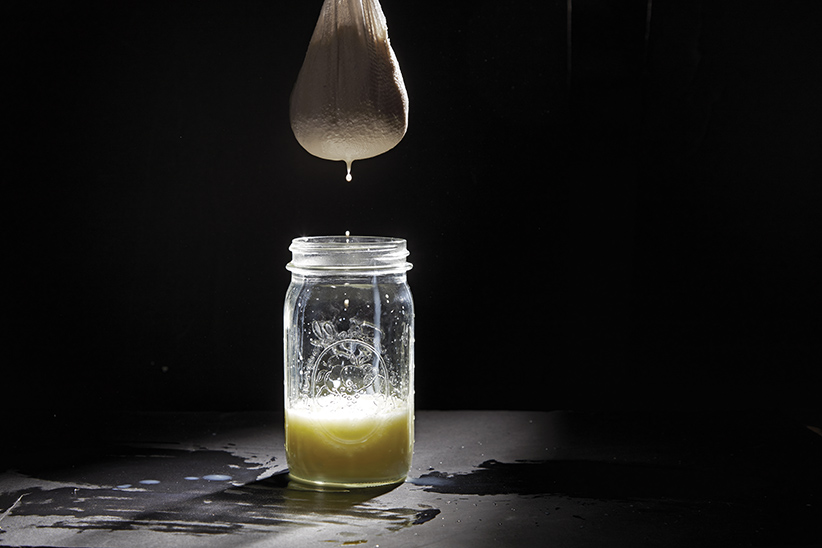A whey-out idea, coming to a restaurant near you
Chefs and a vodka maker are turning whey—essentially dairy waste water—into a food and drink delight
Whey. (Photograph by Reena Newman)
Share

While most of us were looking the other way, a culinary byproduct generally considered to be nuisance waste has discreetly entered the menus of cutting-edge restaurants. Next year, there will be a whole lot more of it. But relax: the rubbish in question is unusually nutritious. And when properly deployed, it contributes to delicious results. It is called whey.
First, consider our whey problem. If you have ever tried cheese-making at its most basic and coaxed a carton of milk into becoming ricotta by adding a little acid, salt and heat, you’ll have a good sense of the dilemma. A litre of milk will yield about 175 ml of ricotta curds—and about 800 ml of a sour, cloudy liquid you will likely pour down the drain.
In commercial cheese-making, some 10 kilos of milk are required to produce one kilo of cheese, leaving somewhere between six and nine kilos of whey. Note that Canada produces more than 400,000 tonnes of cheese each year. Looked at another way, our per-capita cheese consumption runs at about 13 kilos, which by conservative estimate leaves behind 100 litres of unwanted whey. Its makeup—lactose, sugar, bacteria, nutrients—causes microbial havoc in the sewer. It is also frightfully wasteful to put it there, for whey contains a third of the nutrients and all of the sugar from the milk that was turned into cheese. Why throw it out?
Not everyone does. In the Scottish Hebrides they used to drink the stuff unadulterated (not recommended). Hereabouts, it has long been turned into dietary supplements like whey powder. It can be laboriously churned into an expensive, low-fat, tangy and often second-rate butter. You can keep your feta fresher longer when submerged in the liquid. I’ve always understood that the single best use was feeding it to pigs—as they do in Parma, enhancing prosciutto with Parmesan-making waste. But now there is a whole slew of inspired and exciting new uses in play.
For starters, whether you believe in Jesus or not, his first miracle loses some of its lustre when you consider what they are up to at the Black Fly Beverage Co., in London, Ont. What’s the big deal about turning perfectly good water into wine when you compare it to turning waste water into premium martinis? Black Fly’s latest product, Bob’s Super Smooth, is Canada’s first whey-based vodka, and it’s superb: a little creamy, sweet and irreproachably smooth.
“Most vodkas are made from grasses, like wheat or corn,” explains Black Fly co-founder Rob Kelly. “Cows eat grass. So, whey is [essentially] a grass product. Compared to corn or potatoes, it’s a more pristine fermentation medium. That’s the idea behind Bob’s.”
There is no Canadian whey in the product; instead, the distillate is sourced from a distillery in New Zealand which is attached (by drainpipe, as it were) to an adjacent dairy. The distillate made from that whey arrives in Canada at an explosive 96.4-per-cent alcohol, and is then down-proofed with the addition of spring water sourced from Elmvale, Ont., where the clay field filters groundwater into some of the purest in the world. “Our vodka is 59 per cent pristine, sweet Canadian water,” Kelly emphasizes.
Aperitifs aside, whey is also playing an important supporting role on the plate. Calgary’s Pigeonhole restaurant offers an exceptional appetizer of sweetbreads using the liquid. The cooking process begins with all-natural local buttermilk, which is gently heated until it separates into its constituent curd and whey. Both are reserved.
Sweetbreads are customarily poached in an acidulated stock. At Pigeonhole, they are gently poached in the buttermilk whey, infused with aromatics, and left to cool in it before being introduced to the frying pan. “Like brining, it changes the texture,” explains Pigeonhole chef-patron Justin Leboe. “The sweetbreads get firmer but they don’t get rubbery. It also enhances the flavour and contributes acidity.” What’s more, milk sugars in the whey cling to the sweetbreads and help the surface to caramelize in the pan (an effect that can be duplicated at home through the relatively simple application of whey-poached carrots given a quick bronzing sauté just before serving). The curds are blitzed with olive oil to become a smooth, tangy sauce.
Meanwhile, at Actinolite in Toronto, they serve a heritage potato poached in whey and topped with the curds that yielded the whey. At Royal Dinette in Vancouver, they sometimes serve vegetables or protein with a puréed bay leaf-infused reduction of whey and sweet onion. At Pilgrimme on Galiano Island in B.C., whey is used for pickling as well as a vehicle for cooking.
Turning waste into an asset is a cornerstone of the new cookery. You will see much more of it.
Jacob Richler is editor-in-chief of Canada’s 100 Best Restaurants.